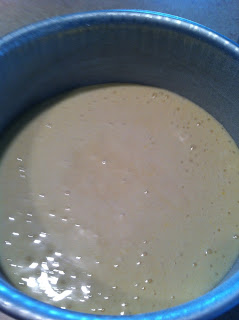Nothing could be easier with this step:
1 1/3 cups flour
2 teaspoons baking powder
1/4 teaspoon Kosher salt
Sift and set aside.
Butter and flour two 6x3-inch pans. So far so good.
1/2 cup whole milk
1/2 cup butter
Butter melted and stirred to incorporate into milk. Cool the combo until it is 80 degrees, but keep stirring to keep the ingredients combined. Check.
In your double boiler (makeshift because I am at the ranch) combine:
1 1/2 cups granulated sugar
3 large eggs
1/2 teaspoon vanilla
Stir over simmering water until the sugar dissolves and the mixture reaches 110 degrees. ( I am a little concerned because I don't think I am going to get a white cake when I'm adding egg yolks, but I persevere.)
Strain to remove the eggy bits.
Then place in mixer and beat with whisk attachment for 10 minutes to cool to 85 degrees. (I THINK I am doing great.) The recipe notes that this step is important for good cake structure.
Slowly add the dry ingredients and then the milk/butter combo. Batter beautiful!
Divide into the two pans and bake at 350 degrees for 30-35 minutes.
Alas, this is where my adventure went awry...
Yes, after editing cookbooks and writing two of my own, I still meet failure in the kitchen. Not only did my cake rise and sink, it was definitely NOT white cake. I will say, the outer rims were delicious, spongy yellow cake. The presentation failed miserably. If I had made this for company, I would have rescued it by filling the "centers" with fruit and top it off with whipped cream.
So, my quest for the perfect, moist white cake continues...
It is in the 20's this morning, but Lucy is undaunted. She is headed off to work in her lovely suede coat. Can't wait to see if there's snow in the forecast. We're so proud of our weather girl!










I have that book too. I just bought it. And some recipes call for this "Hot milk Cake" recipe. So, why did you think this cake failed ?? PLEASE SHARE the reason.
ReplyDeleteI am really stumped about this cake failure. It managed to rise just fine while baking and them had a catastrophic collapse. The usual culprit...old baking soda or powder is not the case here. The only thing I can even begin to suspect was that the final addition of liquid was not cool enough.
ReplyDeleteAfter reading the other cake recipes, I found that I have similar recipes that involve few steps and are not at all temperamental. If you notice the recipe format I use on the blog and in my cookbooks, you will see that it is easier to follow the recipe when you list the ingredients and the procedure for those ingredients rather than just a long list of ingredients and then paragraphs of directions.
I have just really chalked this cookbook up as a lost cause for baking and am just enjoying the photos. Sorry that I do not have a definitive answer.
I have been doing lots of research and baking trials on hot milk and hot water sponge cakes. So far, I have discovered that there are 3 basic methods for making sponge cakes. The recipe in Miette's is the most complicated method... of course. I am working on an easier version, but I'm still in the trial stage.
ReplyDeleteDespite the short list of ingredients, sponge cake (where there is no butter) can be a big test of one's baking skills.
The biggest factor seems to be that the eggs need to be warn (not hot) in order to incorporate lots of air bubbles which cause the cake to rise and be light and spongy. My reading suggests that the egg mixture needs to whip to 4 times its original volume.
Another tip is that a sponge cake made with hot water rises better than one made with hot milk, but I haven't tested that theory.
These are very fussy cakes and must be baked strictly according to directions as to pan prep, technique and popped into the oven immediately.
If you are not a seasoned baker, be aware that true sponge cake is nothing like the texture of a regular cake. It may not be the cake of your dreams. In any case, I am on the job and will report back on the blog when I find the perfect recipe or figure out a fix for Miette's.
Did you ever figure this out?
Delete